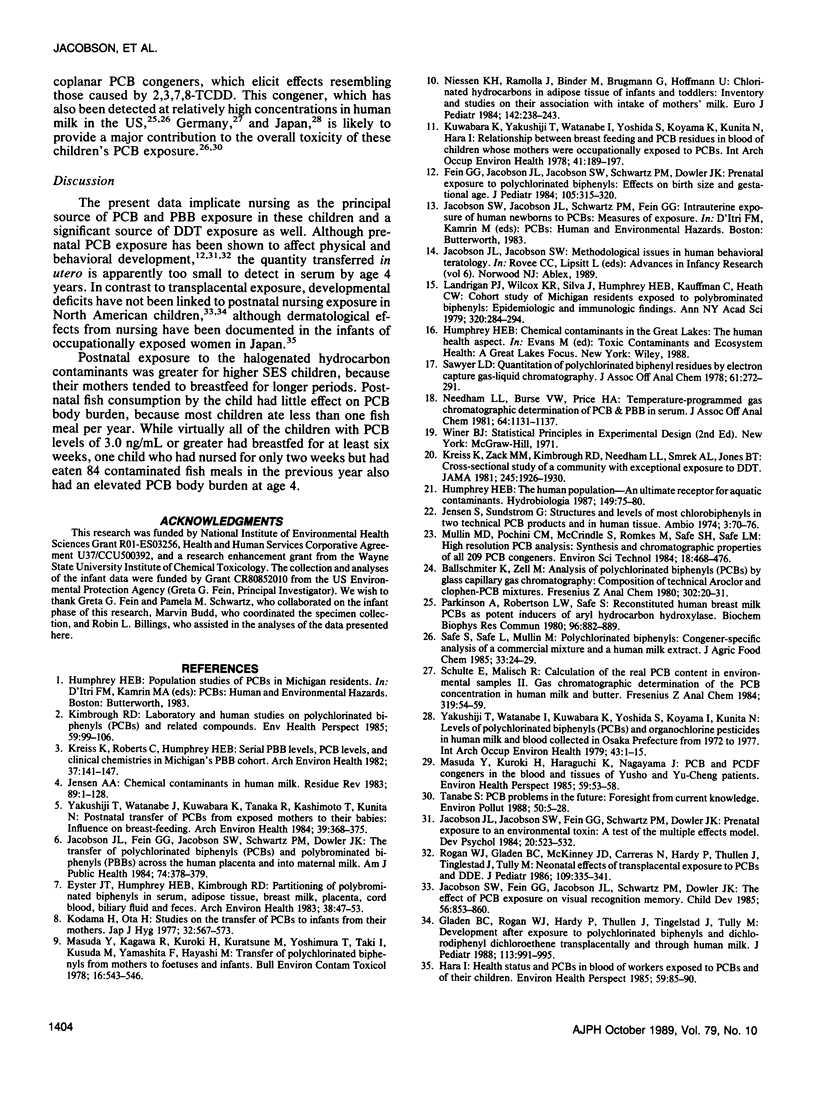Abstract
Serum samples from 285 4-year-old Michigan children were evaluated for levels of 11 environmental contaminants. Polychlorinated biphenyls (PCBs) were found in half the samples tested; polybrominated biphenyls (PBBs) in 13-21 percent; dichlorodiphenyl trichloroethane (DDT), in more than 70 percent. Nursing (Mothers' milk) was the principal source of these exposures. Congener-specific analysis documented the presence of at least one highly toxic PCB congener, 2,3',4,4',5-pentachlorobiphenyl. The data demonstrate the multigenerational impact of female exposure to persistent organic environmental contaminants.
Full text
PDF



Selected References
These references are in PubMed. This may not be the complete list of references from this article.
- Eyster J. T., Humphrey H. E., Kimbrough R. D. Partitioning of polybrominated biphenyls (PBBs) in serum, adipose tissue, breast milk, placenta, cord blood, biliary fluid, and feces. Arch Environ Health. 1983 Jan-Feb;38(1):47–53. doi: 10.1080/00039896.1983.10543978. [DOI] [PubMed] [Google Scholar]
- Fein G. G., Jacobson J. L., Jacobson S. W., Schwartz P. M., Dowler J. K. Prenatal exposure to polychlorinated biphenyls: effects on birth size and gestational age. J Pediatr. 1984 Aug;105(2):315–320. doi: 10.1016/s0022-3476(84)80139-0. [DOI] [PubMed] [Google Scholar]
- Gladen B. C., Rogan W. J., Hardy P., Thullen J., Tingelstad J., Tully M. Development after exposure to polychlorinated biphenyls and dichlorodiphenyl dichloroethene transplacentally and through human milk. J Pediatr. 1988 Dec;113(6):991–995. doi: 10.1016/s0022-3476(88)80569-9. [DOI] [PubMed] [Google Scholar]
- Hara I. Health status and PCBs in blood of workers exposed to PCBs and of their children. Environ Health Perspect. 1985 Feb;59:85–90. doi: 10.1289/ehp.59-1568101. [DOI] [PMC free article] [PubMed] [Google Scholar]
- Jacobson J. L., Fein G. G., Jacobson S. W., Schwartz P. M., Dowler J. K. The transfer of polychlorinated biphenyls (PCBs) and polybrominated biphenyls (PBBs) across the human placenta and into maternal milk. Am J Public Health. 1984 Apr;74(4):378–379. doi: 10.2105/ajph.74.4.378. [DOI] [PMC free article] [PubMed] [Google Scholar]
- Jacobson S. W., Fein G. G., Jacobson J. L., Schwartz P. M., Dowler J. K. The effect of intrauterine PCB exposure on visual recognition memory. Child Dev. 1985 Aug;56(4):853–860. [PubMed] [Google Scholar]
- Jensen A. A. Chemical contaminants in human milk. Residue Rev. 1983;89:1–128. doi: 10.1007/978-1-4612-5601-4_1. [DOI] [PubMed] [Google Scholar]
- Kimbrough R. D. Laboratory and human studies on polychlorinated biphenyls (PCBs) and related compounds. Environ Health Perspect. 1985 Feb;59:99–106. doi: 10.1289/ehp.59-1568093. [DOI] [PMC free article] [PubMed] [Google Scholar]
- Kodama H., Ota H. [Studies on the transfer of PCB to infants from their mothers (1) (author's transl)]. Nihon Eiseigaku Zasshi. 1977 Oct;32(4):567–573. [PubMed] [Google Scholar]
- Kreiss K., Roberts C., Humphrey H. E. Serial PBB levels, PCB levels, and clinical chemistries in Michigan's PBB cohort. Arch Environ Health. 1982 May-Jun;37(3):141–147. doi: 10.1080/00039896.1982.10667553. [DOI] [PubMed] [Google Scholar]
- Kreiss K., Zack M. M., Kimbrough R. D., Needham L. L., Smrek A. L., Jones B. T. Cross-sectional study of a community with exceptional exposure to DDT. JAMA. 1981 May 15;245(19):1926–1930. [PubMed] [Google Scholar]
- Kuwabara K., Yakushiji T., Watanabe I., Yoshida S., Koyama K., Kunita N., Hara I. Relationship between breast feeding and PCB residues in blood of the children whose mothers were occupationally exposed to PCBs. Int Arch Occup Environ Health. 1978 May 12;41(3):189–197. doi: 10.1007/BF00572891. [DOI] [PubMed] [Google Scholar]
- Landrigan P. J., Wilcox K. R., Jr, Silva J., Jr, Humphrey H. E., Kauffman C., Heath C. W., Jr Cohort study of Michigan residents exposed to polybrominated biphenyls: epidemiologic and immunologic findings. Ann N Y Acad Sci. 1979 May 31;320:284–294. doi: 10.1111/j.1749-6632.1979.tb56611.x. [DOI] [PubMed] [Google Scholar]
- Masuda Y., Kagawa R., Kuroki H., Kuratsune M., Yoshimura T., Taki I., Kusuda M., Yamashita F., Hayashi M. Transfer of polychlorinated biphenyls from mothers to foetuses and infants. Food Cosmet Toxicol. 1978 Dec;16(6):543–546. doi: 10.1016/s0015-6264(78)80221-1. [DOI] [PubMed] [Google Scholar]
- Masuda Y., Kuroki H., Haraguchi K., Nagayama J. PCB and PCDF congeners in the blood and tissues of yusho and yu-cheng patients. Environ Health Perspect. 1985 Feb;59:53–58. doi: 10.1289/ehp.59-1568081. [DOI] [PMC free article] [PubMed] [Google Scholar]
- Needham L. L., Burse V. W., Price H. A. Temperature-programmed gas chromatographic determination of polychlorinated and polybrominated biphenyls in serum. J Assoc Off Anal Chem. 1981 Sep;64(5):1131–1137. [PubMed] [Google Scholar]
- Niessen K. H., Ramolla J., Binder M., Brügmann G., Hofmann U. Chlorinated hydrocarbons in adipose tissue of infants and toddlers: inventory and studies on their association with intake of mothers' milk. Eur J Pediatr. 1984 Sep;142(4):238–244. doi: 10.1007/BF00540242. [DOI] [PubMed] [Google Scholar]
- Parkinson A., Robertson L. W., Safe S. Reconstituted human breast milk PCBs as potent inducers of aryl hydrocarbon hydroxylase. Biochem Biophys Res Commun. 1980 Sep 30;96(2):882–889. doi: 10.1016/0006-291x(80)91438-2. [DOI] [PubMed] [Google Scholar]
- Rogan W. J., Gladen B. C., McKinney J. D., Carreras N., Hardy P., Thullen J., Tinglestad J., Tully M. Neonatal effects of transplacental exposure to PCBs and DDE. J Pediatr. 1986 Aug;109(2):335–341. doi: 10.1016/s0022-3476(86)80397-3. [DOI] [PubMed] [Google Scholar]
- Sawyer L. D. Quantitation of polychlorinated biphenyl residues by electron capture gas-liquid chromatography: reference material characterization and preliminary study. J Assoc Off Anal Chem. 1978 Mar;61(2):272–281. [PubMed] [Google Scholar]
- Tanabe S. PCB problems in the future: foresight from current knowledge. Environ Pollut. 1988;50(1-2):5–28. doi: 10.1016/0269-7491(88)90183-2. [DOI] [PubMed] [Google Scholar]
- Yakushiji T., Watanabe I., Kuwabara K., Tanaka R., Kashimoto T., Kunita N., Hara I. Postnatal transfer of PCBs from exposed mothers to their babies: influence of breast-feeding. Arch Environ Health. 1984 Sep-Oct;39(5):368–375. doi: 10.1080/00039896.1984.10545866. [DOI] [PubMed] [Google Scholar]
- Yakushiji T., Watanabe I., Kuwabara K., Yoshida S., Koyama K., Kunita N. Levels of polychlorinated biphenyls (PCBs) and organochlorine pesticides in human milk and blood collected in Osaka Prefecture from 1972 to 1977. Int Arch Occup Environ Health. 1979 Mar 7;43(1):1–15. doi: 10.1007/BF00454276. [DOI] [PubMed] [Google Scholar]


